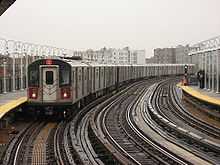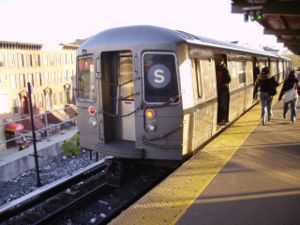R7A (New York City Subway car)
| R7A (New York City Subway car) | |
|---|---|
|
R7A subway car 1575 leading a special holiday train at 23 Street on the IND Sixth Avenue Line | |
|
Interior of R7A car 1575 | |
| In service | 1939 – 1977 |
| Manufacturer | American Car and Foundry, Pullman Standard |
| Built at | Chicago, Illinois, USA |
| Constructed | 1938 |
| Entered service | 1938-1939 |
| Number built | 100 |
| Number preserved | 1 |
| Number scrapped | 99 |
| Fleet numbers |
1550-1599 (Built by Pullman Standard) 1600-1649 (Built by American Car Foundry) (motorized single units) |
| Capacity | 56 (seated) |
| Operator | New York City Subway |
| Specifications | |
| Car body construction | Riveted steel |
| Car length | 60 feet 2 1⁄2 inches (18.35 m) over anticlimbers |
| Width | 10 ft (3.05 m) |
| Height | 12 feet 1 5⁄8 inches (3.70 m) |
| Platform height | 3.76 ft (1.15 m) |
| Doors | 8 |
| Maximum speed | 55 mph (89 km/h) |
| Weight | 84,556 lb (38,354 kg) (ACF), 84,750 lb (38,440 kg) (Pullman), #1575: 82,340 lb (37,350 kg) |
| Traction system | Westinghouse 570-D5 or General Electric 714-D1, 714-D2 |
| Power output | 190 hp (142 kW). |
| Electric system(s) | 600 V DC Third rail |
| Current collection method | Contact shoe |
| Braking system(s) | WABCO Schedule AMUE with UE-5 universal valve, ME-23 brake stand, and simplex clasp brake rigging. WABCO D-3-F air compressor |
| Coupling system | WABCO H2A |
| Track gauge | 4 ft 8 1⁄2 in (1,435 mm) |
The R7A was a New York City Subway car order consisting of 100 cars that were built in 1938 by two separate orders from different manufacturers; the American Car & Foundry (#1600-1649), and Pullman Standard (#1550-1599).[1] Most if not all of these cars were transferred to the BMT Eastern Division in 1968 and 1969 and served there until 1976 and 1977 when the R7As retired.
Preservation
Car 1575 has been preserved by the New York Transit Museum and restored. During its service life, it was rebuilt from its original appearance by ACF in 1947 after an accident, and became the prototype for the R10. It was designed to test new interior and cosmetic features. While it cosmetically resembles an R10, mechanically and electrically it is still an R7A and can only operate with other prewar IND Arnines.
References
- ↑ "Independent Fleet". google.com.
Further reading
- Sansone, Gene. Evolution of New York City subways: An illustrated history of New York City's transit cars, 1867-1997. New York Transit Museum Press, New York, 1997 ISBN 978-0-9637492-8-4
| |||||||||||||||||||||||||||||||||||||||||||||||||||||||||||



